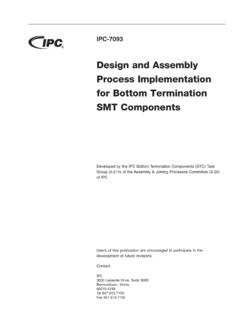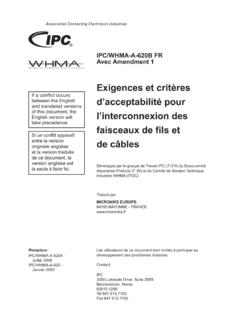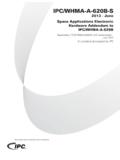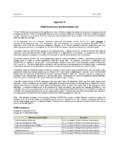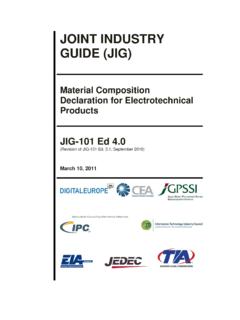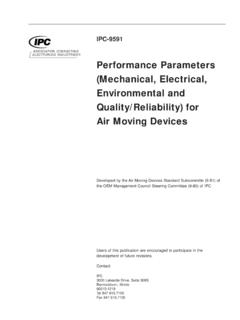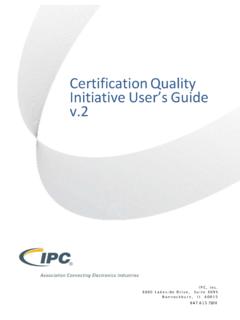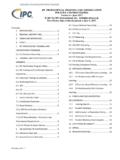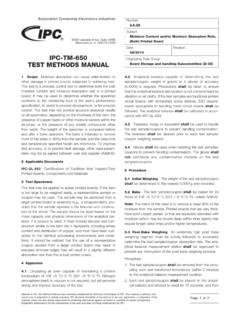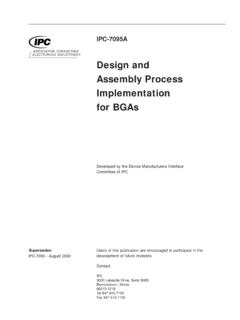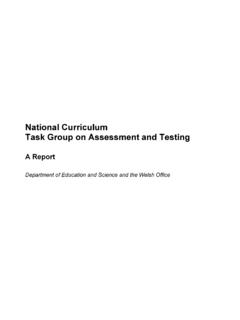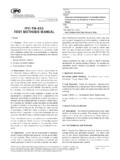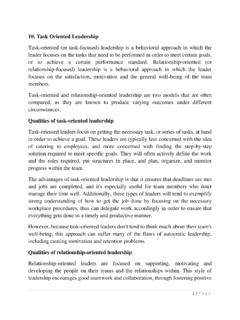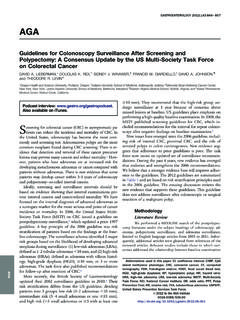Transcription of IPC-TM-650 Originating Task Group TEST METHODS …
1 1 ScopeThis method is to determine the physical endur-ance of printed boards to sudden changes of temperature. Itis designed to expose specimens to a series of high and lowtemperature excursions to cause physical Applicable DocumentsIPC-2221 Generic Standard on Printed Board Design3 Test SpecimenCoupon D from IPC-2221 or other suit-able test coupon (see ).4 automatically controlled dual temperature environ-mental test chamber or other dual chamber apparatuscapable of maintaining 65, 55, 40 or 0 C+0 5 C[ 85, 67, 40, +32 F+0 9 F]inthelowtemperature chamberand 70, 85, 105, 125, 150 or 170 +5 0 C [158, 185, 221,257, 302 or 338 +9 0 F] in the high temperature :The temperature extremes (high and low) that arerequired is dependent on the base material of the specimenthat is to be tested (see and the temperatures listed inTable 2). The recovery capacity of the test chambers shall besuch that the internal chamber temperature shall reach thespecified temperature within two minutes after the speci-men(s) have been transferred to the test chamber.
2 Test con-ditions, if not otherwise stated in the applicable performancespecification (see ), shall meet the requirements ofTable electrical resistance meter capable of accuracies milliohm or better with Kelvin (four terminal) type leads. AKelvin type double bridge or potentiometer of the specifiedaccuracy may also be PreparationWire up test specimen with Kelvin-typeleads at the points where measurements will be chamber (or chambers) and allow to stabilizeat the high and low temperature required. Clamp or suspend-test specimen in the approximate center of the high tempera-ture chamber. Test specimens shall be placed approximately13 mm [ in] apart and aligned in a manner to permit maxi-mum heat transfer to test specimen(s). Thermal Shock test specimens shall be subjected to 100 tem-perature cycles in accordance with Table time between chambers shall be less thantwo minutes. The thermal capacity of the test chamber usedTable 1 StepTest Condition ATest Condition BTest Condition CTemperature C [ F]Time (min)1 Temperature C [ F]Time (min)1 Temperature C [ F]Time (min)110, +0/5 [32, +0/9]15-40, +0/-5 [-40, +0/-9]15-55, +0/-5 [-67, +0/-9]15225, +10/-5 [77, +18/-9]025, +10/-5 [77, +18/-9]025, +10/-5 [77, +18/-9]03+70, +5/-0 [158, +9/-0]15+85, +5/-0 [185, +9/-0]15+105, +5/-0 [221, +9/-0]15425, +10/-5 [77, +18/-9]025, +10/-5 [77, +18/-9]025, +10/-5 [77, +18/-9]0 StepTest Condition DTest Condition ETest Condition FTemperature C [ F]Time (min)1 Temperature C [ F]Time (min)1 Temperature C [ F]Time (min)
3 11-55, +0/-5 [-67, +0/-9]15-65, +0/-5 [-85, +0/-9]15-65, +0/-5 [-85, +0/-9]15225, +10/-5 [77, +18/-9]025, +10/-5 [77, +18/-9]025, +10/-5 [77, +18/-9]03+125, +5/-0 [257, +9/-0]15+150, +5/-0 [302, +9/-0]15+170, +5/-0 [338, +9/-0]15425, +10/-5 [77, +18/-9]025, +10/-5 [77, +18/-9]025, +10/-5 [77, +18/-9]01Or until samples reach test shall be +2 and -0 Sanders RoadNorthbrook, IL 60062-6135 IPC-TM-650 TEST METHODS Shock, Continutity and Microsection,Printed BoardDate05/04 RevisionBOriginating Task GroupRigid Printed Board Performance Task Group (D-33a)Material in this Test METHODS Manual was voluntarily established by Technical Committees of IPC. This material is advisory onlyand its use or adaptation is entirely voluntary. IPC disclaims all liability of any kind as to the use, application, or adaptation of thismaterial. Users are also wholly responsible for protecting themselves against all claims or liabilities for patent referenced is for the convenience of the user and does not imply endorsement by CONNECTINGELECTRONICS INDUSTRIES shall be such that the ambient temperature shall reach thespecified temperature within twp minutes after the test speci-men has been transferred to the appropriate resistance measurements shall betaken before the test, during the first cycle at high tempera-ture, and during the last cycle at high EvaluationThe maximum change in resistancebetween the first and 100th cycle shall be evaluated foracceptability to the requirements of the applicable perfor-mance specification (see ).
4 After testing, a minimum ofthree plated-through holes shall be microsectioned and shallbe evaluated for acceptability to the requirements of the appli-cable performance 2 BASE MATERIAL TYPE DESIGNATORTEST CONDITIONIPC SPECIFICATIONMILITARY1 IPC-4101 IPC-4103S-13949A/01 GTB/02 GXB/03 GPB/04 GRB/05 GYB/20 GEC/21 GFD/22 GBD/24 GFD/25 GFD/26 GFD/28 GFD/29 GFD/50 AFD/53 BID/55 BFD/56 BID/97 GFD/98 GFD/23 GHE/30 GIF/40 GIF/41 GIF/42 GIF/60 QIF1 MIL-S-13949 is canceled and listed for reference Shock, Continutity and Microsection, Printed BoardDate05/04 RevisionBPage2of36 following details are to be specified in the applicableperformance specification:a. Test specimen, if other than specified in Test condition, if other than specified in Maximum allowable change in otherwise specified by the applicable perfor-mance specification, the following base material types/temperature ratings are Shock, Continutity and Microsection, Printed BoardDate05/04 RevisionBPage3of3
